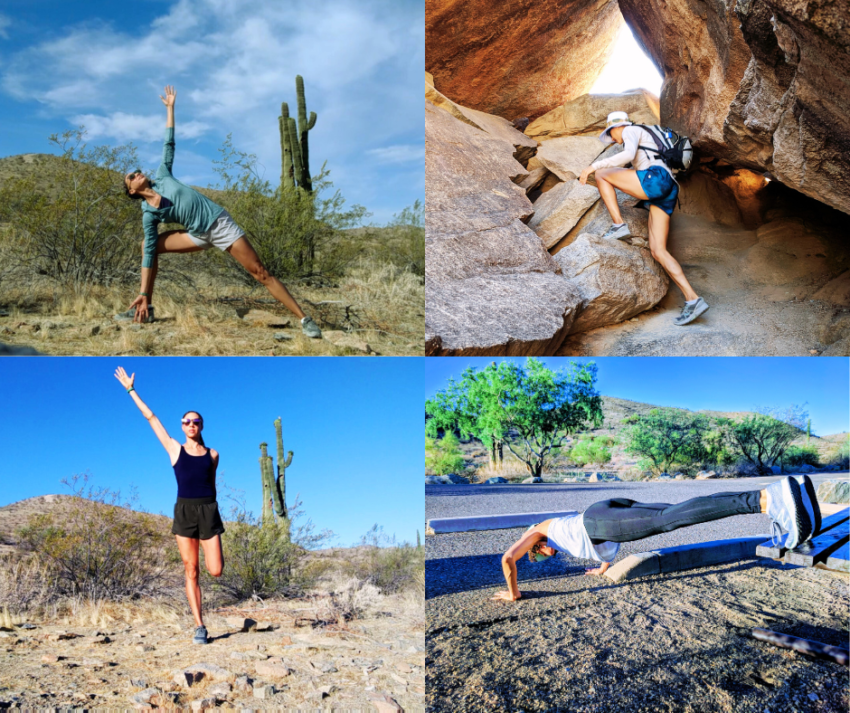There are several factors that contribute to moving well throughout life. Our daily habits are one of the most significant. After all, we are an accumulation of our daily habits. If we regularly practice the the foundational movements we want to perform in daily life, we’re likely to enjoy greater mobility and more comfortable movement as we age.
If our daily habits don’t involve phyisical activity and foundational movement patterns, we’ll liekly get worse at perfoming them. We may even experience a lack of mobility or of comfortable movement. Incorporating these movements into our regular exercise routine is a simple solution to getting the practice we need. So let’s examine 5 foundational movement patterns that keep us capable, independent, and doing the things we love.
1. The Hip Hinge and Squat
Hinging at the hips is the beginning portion of a squat; when we send our glutes behind us. We hinge and squat each time we sit down and get up. Practicing a proper hip hinge helps us to activate each muscle involved in the proper order when we perform the movement in real life. Practicing this movement also ensures we have the mobility, stability, and coordination we need to keep getting up and down in comfort. (American Council on Exercise, 2022) Including almost any variation of a squat into your regular exercise routine will do the trick. Try 3 sets of body-weight squats with 12 repetitions for each set. Consider including weights with your squats after 4-6 training sessions.
2. Pushing
Improperly lifting items overhead or pushing them away from the body can put our shoulders at risk of injury. According to research from the American Council on Exercise, when we practice pushing vertically and horizontally with proper form, we promote shoulder stability, mobility, and proper function. (2022) An overhead press is a simple and effect vertical pushing exercise, while a push-up works well as a horizontal pushing exercise. To add these to your routine try 3 sets of 15 overhead presses with light hand-weights or 3 sets of 12 pushups. Your pushups can be any variation that works for your body. Add one for 4-6 sessions then try the other.
3. Pulling
When we practice pulling we promote healthy posture in the back and shoulders; counteracting the rounded-shoulder effect that often comes from frequent use of handheld devices and long periods of sitting. (American Council on Exercise, 2022) To add pulling practice to your exercise routine try bent over rows. Complete 3 sets, each with 12-15 repetitions using light hand weights. Consider increasing your weights after 4-6 training sessions.
4. Single Leg Movements
Single-leg movements help us avoid and correct muscle imbalances. They give us an opportunity to practice using our stabilizer muscles, or the muscles that protect our joints. When we practice single-leg movements we also improve balance. To bring some balance to your lower body try 3 sets of a single-leg reverse lunges on each side. Completes 10-12 repetitions for each set. Consider adding weights after 4-6 training sessions.
5. Rotational Movements
Rotating happens every time we reach across our bodies – think about pulling a lawn mower to start, shoveling snow, or simply grabbing something off the counter. When we practice rotation we’re strengthening and coordinating our core, shoulders and hips. Wood choppers, an exercise that mimics chopping down a tree, are perfect for practicing rotation. Consider adding 3 sets of wood choppers in each direction to your fitness routine. In each set perform wood choppers for 40 seconds then rest for 20 seconds. After 4-6 sessions, consider adding light hand-weights.
Your Challenge
Now that you’re familiar with 5 foundational movement patterns to keep us capable and moving well, your challenge is to make a plan to practice them regularly. You can exponentially increase the benefits of any exercise or activity by including sunshine and natural space. Walking a few blocks to a neighborhood park to perform these moves under the sun and among the trees will feel so exhilarating you’ll undoubtedly make it a regular routine.
Ready to work on these foundational movements with a pro? You can book a single Personal Training Session or a Personal Training Package. Both options are available online or in-person.
Sources
American Council on Exercise. (2022, October 14). American Council on Exercise Personal Trainer Manual, 5th Edition (5th or later Edition).
